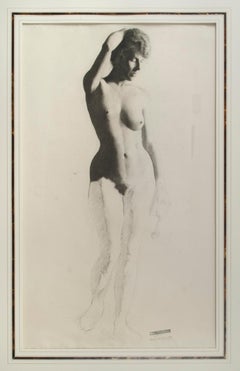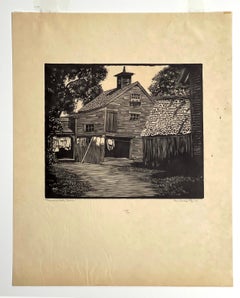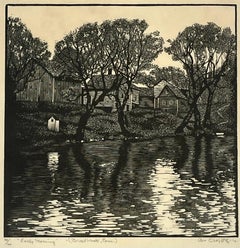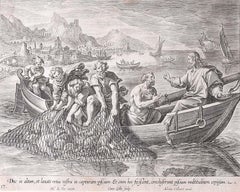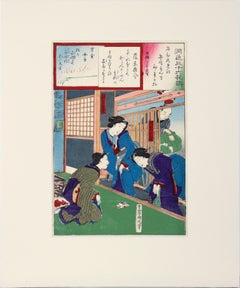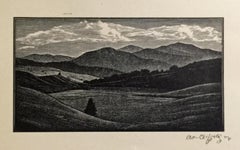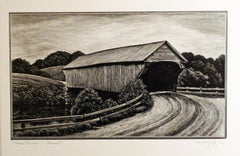Asa Cheffetz Art
to
1
2
1
Overall Width
to
Overall Height
to
4
3
1
3
1
2
2
1
1
1
1
1
1
1
1
1
1
1
1
2
2
1
1
1
4
10,138
2,779
1,375
1,366
4
Artist: Asa Cheffetz
Female Torso, Nude
By Asa Cheffetz
Located in Fairlawn, OH
Nude Female Torso
Charcoal on paper, c. 1920
Stamped and initialed in pencil "Asa Cheffetz/A.D.C"
Estate signature by wife, A.D.C.
Exhibited: Museum of F...
Category
1920s American Realist Asa Cheffetz Art
Materials
Charcoal
Ramshackle Barn (de-accessioned from the Denver Art Museum)
By Asa Cheffetz
Located in New York, NY
Asa Cheffetz
Ramshackle Barn (de-accessioned from the Denver Art Museum), ca. 1929
Wood-engraving
Pencil signed, numbered 27/100 and titled by the artist on the front
13 × 10 1/4 inches
Unframed - affixed to matting
De-accessioned from the collection of the Denver Art Museum
Asa Chaffetz, "the engraver's engraver"
This is the original numbered wood engraving from 1929; not a later re-print
This print was honorable mention in the International Exhibition of prints, Art Institute of Chicago, 1929
Exhibited: New England engraved: The prints of Asa Cheffetz: An Exhibition of his wood engraving & an exploration of his life as an artist. Springfield, MA: Museum of Fine Arts, 1984 (A different example)
Asa Cheffetz Biography:
Born in Buffalo, New York, Cheffetz studied at the School Of The Museum Of Fine Arts in Boston under Philip Leslie Hale...
Category
1920s Realist Asa Cheffetz Art
Materials
Engraving
EARLY MORNING (BROAD BROOK, CONN.)
By Asa Cheffetz
Located in Portland, ME
Cheffetz, Asa EARLY MORNING (BROAD BROOK, CONN.) Wood Engraving,1929. Springfield 15. Edition of 100, numbered 32/100, titled, signed, and inscribed "imp" all in pencil. 6 x 6 inches...
Category
1920s Asa Cheffetz Art
Materials
ABS, Woodcut
UNTITLED - DECANTER AND TWO GLASSES
By Asa Cheffetz
Located in Portland, ME
Cheffetz, Asa. UNTITLED - DECANTER AND TWO GLASSES. Not in Springfield. Wood engraving, undated, but likely 1935-1945. Signed in pencil. 7 x 6 1/8 inches (image) plus margins. A tiny...
Category
1930s Asa Cheffetz Art
Materials
Engraving, Woodcut
Related Items
Adrian Collaert Martin de Vos 17th Century Engraving Miraculous Draught of Fish
By Adriaen Collaert
Located in London, GB
We have the full series of 52 prints (including title page) from Vita Passio et Resurrectio Iesu Christi listed. To find the others scroll down to "More from this Seller" and below i...
Category
17th Century Realist Asa Cheffetz Art
Materials
Engraving
"Enshoku Sanju-roku Kasen" (Thirty-six Enchanting Flowers) Woodblock on paper
By Toyohara Kunichika
Located in Soquel, CA
"Enshoku Sanju-roku Kasen" (Thirty-six Enchanting Flowers) Woodblock on paper
Elegant woodblock print by Toyohara Kunuchika (Japanese, 1835-1900). Three women are in talking with each other inside, while a man waits outside holding a bag of some kind. The colors in this piece are rich and saturated, primarily blues, greens, and purple.
Mat size: 16"H x 20"W
Paper size: 14.75"H x 9.88"W
Born in 1835, Toyohara Kunichika grew up in the Kyobashi district of Edo in the midst of merchants and artisans. In 1848, at age 13, he was accepted as an apprentice into the studio of Utagawa Kunisada I...
Category
1880s Edo Asa Cheffetz Art
Materials
Ink, Rice Paper, Woodcut
$380 Sale Price
20% Off
H 20 in W 16 in D 0.25 in
Flower in Vase (Summer)
Located in Fairlawn, OH
Flower in Vase (Summer)
Color woodblock, c. 1950
Signed "B. Ohno" lower right (see photo)
Sealed lower right (see photo)
Series: Flowers of the Four Se...
Category
1950s Other Art Style Asa Cheffetz Art
Materials
Woodcut
'Flowers and Ko-Imari' — Taisho/Showa Shin Hanga Woodblock Print
Located in Myrtle Beach, SC
Masami Iwata, 'Flowers and Ko-Imari', color woodblock print, c. 1960, edition 250. Signed, and with the artist’s seal, lower right. A superb, painterly impression, with fresh colors,...
Category
1960s Modern Asa Cheffetz Art
Materials
Woodcut
$350
H 18.13 in W 14.75 in
Dahlias
By Nishimura Hodo
Located in Fairlawn, OH
Dahlias
Color woodcut, 1939
Unsigned (as usual)
Format: oban
Publisher: Takemura Hideo
Stamp verso: "Made in Japan"
Provenance: Robert O. Muller
Biography
Hodo Nishimura...
Category
1930s Modern Asa Cheffetz Art
Materials
Woodcut
Victor Rebuffo (1903-1983) - 1956 Woodcut, Encantamiento De La Ribera
Located in Corsham, GB
An original woodcut print by the listed Italian-Argentinian artist Victor Luciano Rebuffo (1903-1983). Entitled 'Encantamiento De La Ribera' Riverside Enchantment. Pencil signed, tit...
Category
Mid-20th Century Asa Cheffetz Art
Materials
Woodcut
Victor Rebuffo (1903-1983) - Mid 20th Century Woodcut, Riachuelo
Located in Corsham, GB
An original woodcut print by the listed Italian-Argentinian artist Victor Luciano Rebuffo (1903-1983). Entitled 'Riachuelo'. The print depicts a stylised waterfront scene with buildi...
Category
20th Century Asa Cheffetz Art
Materials
Woodcut
$595
H 19.3 in W 15.36 in
DESERT BARRIER
By Frances H. Gearhart
Located in Santa Monica, CA
FRANCES H. GEARHART (1869-1958)
DESERT BARRIER c. 1933
Color block print, unsigned 12 x 9 ¼”. Typical original margins on good fibrous japan paper. Many very good impressions by G...
Category
1930s American Impressionist Asa Cheffetz Art
Materials
Woodcut
MB 076 A&B (Double Sided Figurative Charcoal Drawing of Male Nudes)
By Mark Beard
Located in Hudson, NY
Figurative drawing of male nudes made with graphite, charcoal, and conte crayon on Arches paper
30 x 22 inches, unframed
One piece of 30 x 22 inch Arches. Two drawings, one on either...
Category
Early 2000s Modern Asa Cheffetz Art
Materials
Charcoal, Archival Paper, Graphite
$1,600
H 30 in W 22 in
Chrysanthemums
Located in Fairlawn, OH
Chrysanthemums
Color woodcut, c. 1950's
Signed lower right (see photo)
Publisher: Uchida (see photo of red seal)
Note: Chrysanthemums, a symbol of the sun, the Japanese consider the ...
Category
1950s Modern Asa Cheffetz Art
Materials
Woodcut
Flower Vase, Red Camellia, white plum, white daffodils and orchids
Located in Fairlawn, OH
Flower Vase, Red Camellia, white plum, white daffodils and orchids
Color woodcut, c. 1950
Signed "B. Ohno" (see photo)
Seal: Bakufu (see photo)
Series: Flowers of the Four Seasons
Ca...
Category
1950s Other Art Style Asa Cheffetz Art
Materials
Woodcut
$495
H 16.5 in W 11.2 in
Tiger Lily
By Nishimura Hodo
Located in Fairlawn, OH
Tiger Lily
Color woodcut, 1939
Unsigned (as usual)
Publisher: Takemura Hideo
(active Yokohama 1926-1940)
Condition: Excellent
Image/sheet size: 15 3/8 x 10 7/8 inches
Provenance: Robert O. Muller Estate
Biography
Hodo Nishimura...
Category
1930s Modern Asa Cheffetz Art
Materials
Woodcut
Previously Available Items
VERMONT
By Asa Cheffetz
Located in Portland, ME
Cheffetz, Asa. VERMONT. Springfield 59. Wood engraving, 1941. AAA Edition of 250. Signed "Asa Cheffetz, imp" lower right and title "Vermont" lower left. 6 1/4 x 10 inches, 159 x 254 ...
Category
1940s Asa Cheffetz Art
Materials
Engraving, Woodcut
COVERED BRIDGE - VERMONT
By Asa Cheffetz
Located in Portland, ME
Cheffetz, Asa. COVERED BRIDGE. Spfld. 75. Wood-engraving, c. 1945. AAA edition of 250. Titled and signed in pencil. 5 x 8 5/8 inches, 127 x 219 mm. In excellent condition.
Category
1940s Asa Cheffetz Art
Materials
Engraving, Woodcut
Male Torso, Nude
By Asa Cheffetz
Located in Fairlawn, OH
Stamped and initialed in pencil "Asa Cheffetz/A.D.C"
Exhibited: Museum of Fine Arts, Springfield, Massachusetts, with exhibition loan label
Charcoal on laid paper with the Lalanne ...
Category
1920s Asa Cheffetz Art
Materials
Charcoal
BRIDGE OVER MAD RIVER
By Asa Cheffetz
Located in Portland, ME
Cheffetz, Asa. BRIDGE OVER MAD RIVER (VERMONT). Spfld. 84.
Wood-engraving, c. 1947.
AAA edition of 250.
Titled and signed in pencil.
5 1/8 x 7 3/8 inches, 130 x 187 mm.
In excel...
Category
1940s Asa Cheffetz Art
Materials
Engraving, Woodcut
Asa Cheffetz art for sale on 1stDibs.
Find a wide variety of authentic Asa Cheffetz art available for sale on 1stDibs. You can also browse by medium to find art by Asa Cheffetz in engraving, charcoal, woodcut print and more. Not every interior allows for large Asa Cheffetz art, so small editions measuring 11 inches across are available. Customers who are interested in this artist might also find the work of Max Pollak, Jack Beal, and Sacha Chimkevitch. Asa Cheffetz art prices can differ depending upon medium, time period and other attributes. On 1stDibs, the price for these items starts at $375 and tops out at $1,200, while the average work can sell for $800.
